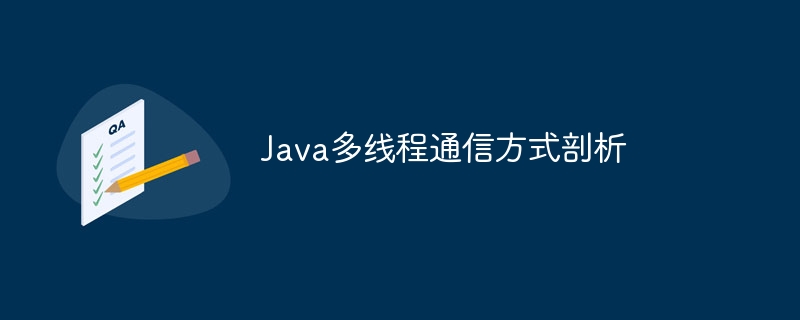Java 멀티스레드 통신 방식 분석
- WBOYWBOYWBOYWBOYWBOYWBOYWBOYWBOYWBOYWBOYWBOYWBOYWB원래의
- 2024-04-12 08:18:01473검색
Java에서는 다중 스레드 통신 방법에는 공유 변수, 대기/알림, 세마포어 및 파이프가 포함됩니다. 공유 변수는 데이터 교환을 용이하게 하지만 동시성 문제가 발생하기 쉽습니다. 대기/알림은 동기화 메커니즘을 사용하여 동시에 리소스에 액세스하는 스레드 수를 제한합니다. 파이프는 스레드 간에 데이터를 전송하기 위해 버퍼를 사용합니다.

Java 멀티스레드 통신 분석
소개
멀티스레딩은 여러 작업을 동시에 실행할 수 있는 동시 프로그래밍의 중요한 개념입니다. 멀티스레드 환경에서 데이터 교환을 구현하기 위해서는 다양한 통신 방식을 이해해야 합니다. 이 기사에서는 공유 변수, 대기/알림, 세마포어 및 파이프를 포함하여 Java의 일반적인 다중 스레드 통신 방법을 심층적으로 살펴보겠습니다.
공유 변수
공유 변수는 여러 스레드에서 액세스할 수 있는 전역 변수입니다. 한 스레드가 공유 변수를 수정하면 다른 스레드가 변경 사항을 볼 수 있습니다. 그러나 공유 변수는 경쟁 조건 및 예측할 수 없는 동작과 같은 동시성 문제가 발생하기 쉽습니다.
실용 사례:
public class SharedVariableExample {
private static int sharedCounter = 0;
public static void main(String[] args) throws InterruptedException {
Thread thread1 = new Thread(() -> {
for (int i = 0; i < 1000; i++) {
sharedCounter++;
}
});
Thread thread2 = new Thread(() -> {
for (int i = 0; i < 1000; i++) {
sharedCounter--;
}
});
thread1.start();
thread2.start();
thread1.join();
thread2.join();
System.out.println("最终共享计数器:" + sharedCounter);
}
}wait/notify
wait/notify는 Java에 내장된 동기화 메커니즘입니다. wait() 메소드는 다른 스레드가 inform() 또는 informAll() 메소드를 호출하여 깨어날 때까지 현재 스레드를 대기 상태로 전환합니다.
실용 사례:
public class WaitNotifyExample {
private static Object lock = new Object();
private static boolean dataAvailable = false;
public static void main(String[] args) throws InterruptedException {
Thread producer = new Thread(() -> {
synchronized (lock) {
while (!dataAvailable) {
try {
lock.wait();
} catch (InterruptedException e) {
e.printStackTrace();
}
}
System.out.println("处理数据...");
}
});
Thread consumer = new Thread(() -> {
synchronized (lock) {
dataAvailable = true;
lock.notify();
}
});
producer.start();
consumer.start();
producer.join();
consumer.join();
}
}세마포
세마포는 특정 수의 스레드가 동시에 리소스에 액세스할 수 있도록 하는 동기화 메커니즘입니다. 스레드가 세마포어를 획득하면 세마포어 카운터가 감소하고, 세마포어를 해제하면 카운터가 증가합니다.
실용 사례:
public class SemaphoreExample {
private static Semaphore semaphore = new Semaphore(2);
public static void main(String[] args) throws InterruptedException {
Thread thread1 = new Thread(() -> {
try {
semaphore.acquire();
System.out.println("线程 1 进入临界区");
} catch (InterruptedException e) {
e.printStackTrace();
} finally {
semaphore.release();
}
});
Thread thread2 = new Thread(() -> {
try {
semaphore.acquire();
System.out.println("线程 2 进入临界区");
} catch (InterruptedException e) {
e.printStackTrace();
} finally {
semaphore.release();
}
});
thread1.start();
thread2.start();
thread1.join();
thread2.join();
}
}Pipeline
Pipeline은 스레드 간 통신에 사용되는 특수 데이터 구조입니다. 이는 버퍼와 같습니다. 한 스레드는 데이터를 쓸 수 있고 다른 스레드는 데이터를 읽을 수 있습니다.
실제 사례:
public class PipeExample {
private static PipedOutputStream pos = new PipedOutputStream();
private static PipedInputStream pis = new PipedInputStream(pos);
public static void main(String[] args) throws IOException {
Thread writer = new Thread(() -> {
try {
pos.write("你好,世界!".getBytes());
} catch (IOException e) {
e.printStackTrace();
} finally {
pos.close();
}
});
Thread reader = new Thread(() -> {
try {
byte[] data = new byte[1024];
int length = pis.read(data);
System.out.println(new String(data, 0, length));
} catch (IOException e) {
e.printStackTrace();
} finally {
pis.close();
}
});
writer.start();
reader.start();
writer.join();
reader.join();
}
}위 내용은 Java 멀티스레드 통신 방식 분석의 상세 내용입니다. 자세한 내용은 PHP 중국어 웹사이트의 기타 관련 기사를 참조하세요!

